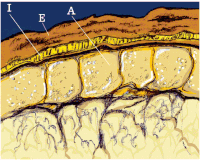
Photo from wikipedia
Background and objectives Compared to wheat bran, less information on physicochemical characteristics and health-related effects is available for bran from other cereals and results are often confounded by residual endosperm.… Click to show full abstract
Background and objectives Compared to wheat bran, less information on physicochemical characteristics and health-related effects is available for bran from other cereals and results are often confounded by residual endosperm. Therefore, the objective of this study was to compare structure and composition of endosperm-depleted bran of wheat, rye, oat, and maize, and link these characteristics to fecal fermentation characteristics. Findings Compared to wheat, endosperm-depleted rye bran contained twice the amount of fructan (8.0% dm) and water-extractable arabinoxylan (1.4% dm). Oat bran had a more open structure and was rich in (1,3:1,4)-beta-glucan (17.0% dm). For rye and oat bran, and to a lesser extent wheat bran, fermentation with fecal microbiota resulted in short chain fatty acid production, with full metabolization of fructan and beta-glucan after 2 and 24 hr of fecal fermentation, respectively. For maize bran, a less accessible structure containing over 70% of arabinoxylan and cellulose was coupled to a lower degree of fecal fermentation. Conclusion Removal of endosperm as a confounding factor when studying bran properties allowed us to obtain more accurate estimates of the composition, structure, and some physicochemical characteristics of bran of wheat, rye, oat, and maize. Bran fecal fermentation characteristics were mainly determined by composition and to a lesser extent by accessibility of the structure. Significance and novelty This is the first study that compares composition, structure, and fecal fermentation characteristics of wheat, rye, oat, and maize bran, after eliminating endosperm as a confounding factor. The knowledge obtained will allow a more goal-oriented choice of bran type for incorporation into food products, depending on targeted physiological effects and nutritional impact.
Journal Title: Cereal Chemistry
Year Published: 2019
Link to full text (if available)
Share on Social Media: Sign Up to like & get
recommendations!